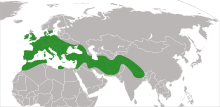Our website is made possible by displaying online advertisements to our visitors.
Please consider supporting us by disabling your ad blocker.
Arum
| Arum | |
|---|---|

| |
| Arum palaestinum | |
| Scientific classification | |
| Kingdom: | Plantae |
| Clade: | Tracheophytes |
| Clade: | Angiosperms |
| Clade: | Monocots |
| Order: | Alismatales |
| Family: | Araceae |
| Subfamily: | Aroideae |
| Tribe: | Areae |
| Genus: | Arum L. |

| |
| Range of the genus Arum | |
| Synonyms[1] | |
| |
Arum is a genus of flowering plants in the family Araceae, native to Europe, northern Africa, and western and central Asia, with the highest species diversity in the Mediterranean region.[1][2] Frequently called arum lilies, they are not closely related to the true lilies Lilium. Plants in the closely related genus Zantedeschia are also called 'arum lilies'.

They are rhizomatous, herbaceous perennial plants growing to 20–60 cm tall, with sagittate (arrowhead-shaped) leaves 10–55 cm long. The flowers are produced in a spadix, surrounded by a 10–40 cm long, distinctively coloured spathe, which may be white, yellow, brown, or purple. Some species are scented, others not. The fruit is a cluster of bright orange or red berries.
All parts of the plants, including the berries, are poisonous as they contain needle-shaped crystals of calcium oxalate.[3] In spite of this, the plant has a history of culinary use among Arab peasants in Palestine who leached the toxins from the plant before the leaves were consumed.[4][5][6]
The genus name is the Latinized form of the Greek name for these plants, aron.
- ^ a b Kew World Checklist of Selected Plant Families
- ^ Govaerts, R. & Frodin, D.G. (2002). World Checklist and Bibliography of Araceae (and Acoraceae): 1-560. The Board of Trustees of the Royal Botanic Gardens, Kew.
- ^ Nelson, L. et al. (2007) Handbook of Poisonous and Injurious Plants. New York Botanical Garden.
- ^ Ḳrispil, Nissim (1985). A Bag of Plants (The Useful Plants of Israel) (in Hebrew). Vol. 3 (Ṭ.-M.). Jerusalem: Cana Publishing House Ltd. ISBN 965-264-011-5. OCLC 959573975., s.v. Arum palaestinum (לוף)
- ^ Dalman, Gustaf (2020). Nadia Abdulhadi-Sukhtian (ed.). Work and Customs in Palestine, volume II. Vol. 2 (Agriculture). Translated by Robert Schick. Ramallah: Dar Al Nasher. p. 329. ISBN 978-9950-385-84-9.
- ^ Mayer-Chissick, Uri; Lev, Efraim (2016). "Wild Edible Plants in Israel Tradition Versus Cultivation". In Yaniv, Zohara; Dudai, Nati (eds.). Medicinal and Aromatic Plants of the Middle-East. New York: Dordrecht: Springer. pp. 18–20. ISBN 9789402406603. OCLC 1062304427.
Previous Page Next Page


